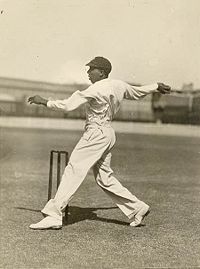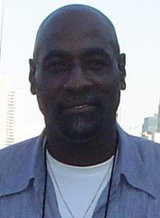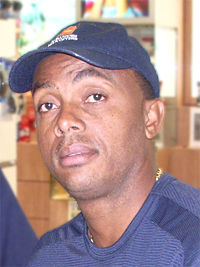West Indies cricket team
2008/9 Schools Wikipedia Selection. Related subjects: Sports teams
| West Indies | |
| Test status granted | 1928 |
|---|---|
| First Test match | v England at Lord's, June 1928 |
| Captain | Ramnaresh Sarwan |
| Coach | John Dyson |
| Official ICC Test and ODI ranking | 8th (Test), 8th (ODI) |
| Test matches - This year |
429 5 |
| Last Test match | v England at County Durham, 14 June 2007 |
| Wins/losses - This year |
{{{win 3/loss record}}} 1/3 |
| As of 29 December 2007 | |

The West Indian cricket team, also known colloquially as The Windies or The West Indies, is a multi-national cricket team representing a sporting confederation of a dozen English-speaking Caribbean countries and British dependencies that form the British West Indies.
As of December 2007, the West Indian team has played 441 Test matches, winning 34.01%, losing 31.97% and drawing 33.78% of its games.
History
The history of the West Indies cricket team begins in the 1890s, when the first representative sides were selected to play visiting English sides. Administered by the West Indies Cricket Board ("WICB"), and known colloquially as The Windies, the West Indies cricket team represents a sporting confederation of English-speaking Caribbean countries.
The WICB joined the sport's international ruling body, the Imperial Cricket Council, in 1926, and played their first official international match, granted Test status, in 1928. Although blessed with some great players in their early days as a Test nation, their successes remained sporadic until the 1960s, by which time the side had changed from a white-dominated to a black-dominated side. By the 1970s, the West Indies had a side recognised as unofficial world champions, a title they retained throughout the 1980s. During these glory years, the Windies were noted for their four-man fast bowling attack, backed up by some of the best batsmen in the world. The 1980s saw them set a then-record streak of 11 consecutive Test victories in 1984 and inflict two 5–0 "blackwashes" against the old enemy of England. Throughout the 1990s and 2000s, however, West Indian cricket declined, largely due to the failure of the West Indian Cricket Board to move the game from an amateur pastime to a professional sport coupled with the general economic decline in West Indian countries, and the team today is struggling to regain its past glory.
In their early days in the 1930s, the side represented the British colonies of the West Indies Federation plus British Guiana. The current side represents the now independent states of Antigua and Barbuda, Barbados, Dominica, Grenada, Guyana, Jamaica, Saint Kitts and Nevis, Saint Lucia, Saint Vincent and the Grenadines and Trinidad and Tobago, the British dependencies of Anguilla, Montserrat and the British Virgin Islands, plus the U.S. Virgin Islands and St. Maarten. National teams also exist for the various different islands, which, as they are all separate countries, very much keep their local identities and support their local favourites. These national teams take part in the West Indian first-class competition, the Carib Beer Cup (earlier known as the Busta Cup, Shell Shield and various other names). It is also common for other international teams to play the island teams for warm-up games before they take on the combined West Indies team.
Flag
Most cricketing nations use their own national flags for cricketing purposes. However, as the West Indies represent a number of independent and dependent states, there is no natural choice of flag. The WICB has therefore developed an insignia showing a palm tree and cricket stumps on a small sunny island. This insignia, on a maroon background, makes up the West Indian flag. The background sometimes has a white stripe above a green stripe, which is separated by a maroon stripe, passing horizontally through the middle of the background.
Stadia

The following nine stadia have been used for at least one Test match. The number of Tests played at each venue followed by the number of one-day internationals played at that venue is in brackets:
- Kensington Oval in Bridgetown, Barbados (43/19)
Recognised as the 'Mecca' of West Indies cricket, Kensington Oval hosted the region's first Test match in 1930. It also played host to the first-ever Test triple century, Andy Sandham's 325. It's capacity has been increased from 15,000 to its current 28,000 for the 2007 World Cup. It hosted the World Cup final.
- Queen's Park Oval in Port of Spain, Trinidad (54/42)
The Queen's Park Oval first hosted a Test match in 1930. It has a capacity of 25,000.
- Bourda in Georgetown, Guyana (30/10)
Bourda first hosted a Test match in 1930. It is the only Test ground in South America, and the only one below sea level. It has a capacity of around 22,000.
- Sabina Park in Kingston, Jamaica (41/17)
Sabina Park first hosted a Test match in 1930. The Blue Mountains, which are famed for their coffee, form the backdrop. Sabina Park played host to Garry Sobers' then world-record 365 not out. In 1998 the Test against England was abandoned here on the opening day because the pitch was too dangerous. It has a capacity of 15,000.
- Antigua Recreation Ground in St. John's, Antigua and Barbuda (20/6)
Antigua Recreation Ground first hosted a Test in 1981. Three Test triple centuries have been scored on this ground: Chris Gayle's 317 in 2005, and Brian Lara's world record scores of 375 in 1994 and 400 not out in 2004. The historic stadium hosted its final international cricket match in June 2006, to make way for the island's new cricket stadium, being constructed 3 miles outside the capital city expected to be completed in time for its hosting of matches for Cricket World Cup 2007.
- Arnos Vale Ground in Arnos Vale, Kingstown, St Vincent (1/16)
The Arnos Vale Ground first hosted a Test in 1997.
- National Cricket Stadium in St George's, Grenada (1/8)
The National Cricket Stadium first hosted a Test in 2002.
- Beausejour Stadium in Gros Islet, St Lucia (2/7)
The Beausejour Stadium first hosted a Test in 2003. It has a capacity of 12,000. This was the first stadium in the Caribbean to host a day-night cricket match. The match was between the West Indies and Zimbabwe.
- Warner Park Stadium in Basseterre, Saint Kitts and Nevis (1/1)
The Warner Park Sporting Complex hosted its first one day international on May 23, 2006 and its first test match on 22 June 2006. The stadium has a permanent capacity of 8,000, with provisions for temporary stands to enable the hosting figure to past 10,000.
Three further stadia have been used for one-day internationals, but not Test matches. The number of one-day internationals played at each venue is in brackets:
- Albion Sports Complex in Albion, Berbice, Guyana (5)
- Mindoo Phillip Park in Castries, St Lucia (2)
- The old ground of Queen's Park in St George's, Grenada (1)
Colours
When playing one-day cricket, the Windies wear a maroon shirt, with grey around the sides. At present the shirt also sports the logo of the West Indian Cricket Board and the name of their sponsors, Digicel. The one-day cap is maroon with the WICB logo on the left of the front, with two yellow stripes separated by a green stripe running vertically on the right of the front.
When playing first-class cricket, in addition to their cricket whites, West Indian fielders sometimes wear a sunhat, which is maroon and has a wide brim. The WICB logo is on the middle of the front of the hat. Helmets are coloured similarly.
During World Series Cricket, colour uniforms were adopted. The initial West Indies uniform was pink. Later, the uniform was changed to maroon to match their test match caps. Grey was also added as as secondary colour. In some of their uniforms grey has been dominant over the traditional maroon.
West Indian women's cricket team
The West Indian women's cricket team has a much lower profile than the men's team. They played 11 Test matches between 1975-76 and 1979, winning once, losing three times, and drawing the other games. Since then, they have only played one further Test match, a draw game against Pakistan in 2003-04. They also have an infrequent record in one-day internationals. A team from Trinidad and Tobago and a team from Jamaica played in the first women's World Cup in 1973, with both sides faring poorly, finishing fifth and sixth respectively out of a field of seven. The Windies united as a team to play their first ODI in 1979, but thereafter did not play until the 1993 World Cup. The side has never been one of the leading sides in the world, however, with their main success being achieving second place in the International Women's Cricket Council Trophy, a competition for the second tier of women's national cricket teams, in 2003. They finished in fifth place in the most recent World Cup, which was held in 2004-05. Their overall record in one-dayers is to have played 45, won 17, lost 27 with one no result.
Because of the women's side's relatively low profile, there are few well-known names in the game. The most notable is probably Nadine George, a wicket-keeper/ batsman, who became the first, and to date only, West Indian woman to score a Test century in Karachi, Pakistan in 2003-04. George is a prominent supporter of sport in the West Indies, and in particular in her native St Lucia, and in 2005 was made an MBE by HRH The Prince of Wales for services to sport.
Statistics and records
Test matches
- Innings totals above 700
For: 790 for 3 declared against Pakistan in Kingston in 1957-58; 751 for 5 declared against England in St John's in 2003-04; 747 all out against South Africa in St John's in 2004-05
Against: 849 by England in Kingston in 1929-30; 758 for 8 declared by Australia in Kingston in 1954-55
- Innings totals below 60
For: 47 against England in Kingston in 2003-04; 51 against Australia in Port of Spain in 1998-99; 53 against Pakistan in Faisalabad in 1986-87; 54 against England at Lord's in 2000
Against: 46 by England in Port of Spain in 1993-94
- Triple centuries scored for the Windies
400 not out by Brian Lara against England at St John's in 2003-04; 375 by Brian Lara against England at St John's in 1993-94; 365 not out by Garry Sobers against Pakistan at Kingston in 1957-58; 317 by Chris Gayle against South Africa at St John's in 2004-05; 302 by Lawrence Rowe against England at Bridgetown in 1973-74
- Twelve or more wickets taken for the Windies in a Test match
14 for the cost of 149 runs by Michael Holding against England at the Oval in 1976; 13 for 55 by Courtney Walsh against New Zealand in Wellington in 1994-95; 12 for 121 by Andy Roberts against India in Madras in 1974-75
One day matches
- Hat-trick
The first and only ever hat-trick performance was made by Jerome Taylor on October 19, 2006 at Mumbai in an ICC Champions Trophy league match against Australia...
Twenty20 matches
The West Indies have played six twenty20 internationals, the first against New Zealand being the first tie to ever take place. The West Indies however lost on a bowl-out.
The second match was played against England at the Brit Oval, and was the West Indies first victory in this format, by 15 runs. They lost the return match, also at the Brit Oval, by five wickets.
Their fourth and fifth matches came in the 2007 ICC World Twenty20 in South Africa; both were lost as they were beaten by hosts South Africa and Bangladesh.
The West Indies won their seventh game against South Africa by five wickets in December 2007.
Current squad
Support staff
- Team manager: Mike Findlay
- Head Coach: John Dyson
- Assistant Coach: Henderson Springer
- Physiotherapist: Stephen Partridge
- Strength & Conditioning Coach: Richard Smith
- Performance Enhancment Consultant: David Scott
- Media Liaison Officer: Imran Khan
- Last Captain: Brian Lara
Famous players
A list of the most notable players, by decade in which they first represented the West Indies, is below:
- 1920s: Learie Constantine
- 1930s: George Headley, Manny Martindale
- 1940s: Clyde Walcott, Everton Weekes, Frank Worrell (collectively known as the Three W's)
- 1950s: Basil Butcher, Lance Gibbs, Wes Hall, Conrad Hunte, Rohan Kanhai, Sonny Ramadhin, Garry Sobers, Alfred Valentine
- 1960s: Charlie Griffith, Vanburn Holder, Clive Lloyd, Seymour Nurse
- 1970s: Colin Croft, Joel Garner, Larry Gomes, Gordon Greenidge, Desmond Haynes, Michael Holding, Roy Fredericks, Alvin Kallicharran, Malcolm Marshall, Viv Richards, Andy Roberts, Lawrence Rowe
- 1980s: Curtly Ambrose, Ian Bishop, Jeff Dujon, Carl Hooper, Richie Richardson, Courtney Walsh
- 1990s: Jimmy Adams, Ridley Jacobs, Brian Lara
- 2000s: Ramnaresh Sarwan, Chris Gayle, Dwayne Bravo, Shivnarine Chanderpaul, Devon Smith, Corey Collymore
Captains of the Test side
The following men have captained the West Indian cricket team in at least one Test match:
| West Indian Test match captains | ||
|---|---|---|
| Number | Name | Period |
| 1 | Karl Nunes | 1928-1929/30 |
| 2 | Teddy Hoad | 1929/30 |
| 3 | Nelson Betancourt | 1929/30 |
| 4 | Maurice Fernandes | 1929/30 |
| 5 | Jackie Grant1 | 1930/31-1934/35 |
| 6 | Rolph Grant1 | 1939 |
| 7 | George Headley | 1947/48 |
| 8 | Gerry Gomez | 1947/48 |
| 9 | John Goddard | 1947/48-1951/52, 1957 |
| 10 | Jeffrey Stollmeyer | 1951/52-1954/55 |
| 11 | Denis Atkinson | 1954/55-1955/56 |
| 12 | Gerry Alexander | 1957/58-1959/60 |
| 13 | Frank Worrell | 1960/61-1963 |
| 14 | Garfield Sobers | 1964/65-1971/72 |
| 15 | Rohan Kanhai | 1972/73-1973/74 |
| 16 | Clive Lloyd | 1974/75-1977/78, 1979/80-1984/85 |
| 17 | Alvin Kallicharran | 1977/78-1978/79 |
| 18 | Deryck Murray | 1979/80 |
| 19 | Viv Richards | 1980, 1983/84-1991 |
| 20 | Gordon Greenidge | 1987/88 |
| 21 | Desmond Haynes | 1989/90-1990/91 |
| 22 | Richie Richardson | 1991/92-1995 |
| 23 | Courtney Walsh | 1993/94-1997/98 |
| 24 | Brian Lara | 1996/97-1999/2000, 2002/03-2004, 2006-2007 |
| 25 | Jimmy Adams | 1999/2000-2000/01 |
| 26 | Carl Hooper | 2000/01-2002/03 |
| 27 | Ridley Jacobs | 2002/03 |
| 28 | Shivnarine Chanderpaul | 2004/05-2005/06 |
| 29 | Ramnaresh Sarwan | 2007-incumbent |
| 30 | Chris Gayle | 2007 |
Note: 1 Jackie and Rolph Grant were brothers
Tournament history and honours
World Cup
(this is the leading international one-day tournament, held approximately every four years since 1975)
- 1975: Champions
- 1979: Champions
- 1983: Runners up
- 1987: First round
- 1992: First round (6th place)
- 1996: Semi Finals
- 1999: First round
- 2003: First round
- 2007: Super Eight stage (6th place)
ICC Champions Trophy
(this is the only other one-day tournament featuring all the top international cricket teams, held every two years since 1998; known as the "ICC Knockout" in 1998 and 2000)
- 1998: Runners up
- 2000: First round
- 2002: First round
- 2004: Champions
- 2006: Runners up
World Championship of Cricket
- 1985: Third place



